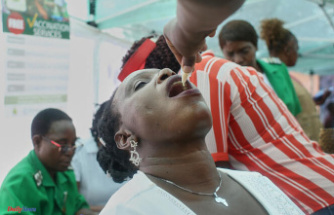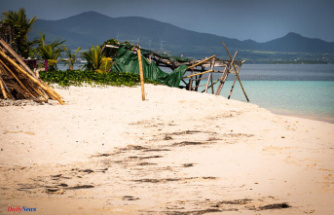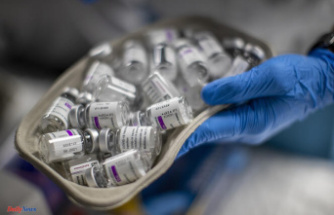It happened without warning. July 27, 2022, in the small village of Clansayes, in the south of the Drôme department. Suddenly, nothing came out of the taps. A sudden, widespread outage. “You wake up in the morning and there’s no water at all. You don’t immediately understand what’s happening,” says Maryannick Garin, mayor of the village of 600 inhabitants. Pipe break? Much more serious. While looking for the origin of the cut, the municipality realized that the level of the water table had dropped too much because of the drought which had lasted for months. The pumps are no longer able to tap into the source that has always supplied the town.
“It’s a huge shock. We feel vulnerable, everyone understands how precious water is,” says the elected official, who is also vice-president of the rural mayors of Drôme. For three days, the village was repaired by tanker trucks, then it was connected to the network of the neighboring intercommunal union, which draws on the Rhône aquifer. The water is flowing again. But nothing is really the same as before in the magnificent stone town, surrounded by vegetation. A direct witness to the most radical effects of water stress in the Auvergne-Rhône-Alpes region, the village of Clansayes embodies the awareness of a future where the preservation of water will become a central issue.
“We experienced another period of intense drought this year. Things change. Residents are starting to find small, everyday gestures to save money, gestures that we had lost the habit of, notes Maryannick Garin. We are not talking about a power or Internet outage. Water is not a communal heritage, it is a world heritage, we must seriously question its management, individually and collectively. » The debate is launched in a region among the most exposed to climate change.
Misleading effect
The Auvergne-Rhône-Alpes region (AURA) experienced in 2022 the second hottest summer in documented meteorological history, after that of 2003, with a temperature 2.5°C higher than the average of the last twenty years . At the same time, the region suffered its second driest period, with rainfall down 23% compared to the average since 1960. More heat, less rain and snow in winter: water resources are decreasing inexorably. “The region is fully engaged with the issue of climate change. It is undoubtedly the most exposed to the extreme phenomena that we see. In this context, water towers no longer function as before. The year 2023 gives us a snapshot of what awaits us by 2050,” estimates Jean-Michel Soubeyroux, deputy scientific director at Météo-France.
In recent weeks, intense rainy episodes have made us forget the previous months of drought. A misleading effect. “We are likely to see an increase in record number of days without rain, followed by record amounts of precipitation. Ultimately, the water balance is negative,” continues the Météo-France engineer. The consequences are visible in the second largest economic region of France. Between 1960 and 2020, the flow of the Rhône fell by 7% in its northern sector, and by 13% in the south. Its temperature increased by 2.2°C in the north, and up to 4.5°C in the south. Crossing the entire region, the river directly supplies water to 2.3 million people and provides irrigation for 2,700 farms.
Rising temperatures will require changes to the operation of the four nuclear power plants located on the banks of the river and their eighteen reactors. Objective: to limit water discharge from cooling circuits during periods that are too hot. The slowdown in production in summer must particularly concern the three power plants which operate in open circuit. This single question of nuclear power plants gives the measure of the efforts to be accomplished: switching two nuclear power plants to a closed circuit requires work costing one billion euros.
Responsible for managing the river, the Compagnie nationale du Rhône (CNR) has been sounding the alarm for several years. The company created by Edouard Herriot manages to maintain navigation and the level of the pumping stations thanks to its permanent regulation of the river, but it has already had to change its practices, for environmental reasons. The schedule of maintenance operations has been modified to deal with unprecedented weather events. “We carry out between 400 and 500 interventions per year across all of our installations. But as flow variations become difficult to predict, we can no longer program everything months in advance. We must give ourselves the flexibility to intervene quickly,” explains Eric Divet, director of asset management and concessions at CNR.
Debris flows
To deal with water stress, the CNR has a Center for behavioral analysis of hydraulic structures (Cacoh). This cutting-edge laboratory models, for example, the phenomena of “crash flows”, when storms or rain occur which cause the tributaries of the Rhône to overflow, particularly on mountain slopes. Engineers are able to visualize the behavior of these flows, composed of 15% water and 85% carried materials. They develop solutions to avoid flooding. The construction of so-called “distribution” structures, upstream of dams or reservoirs, makes it possible to split and spread the volumes of the flows. This avoids catastrophic overflows.
“By understanding these phenomena, which operate in bursts, we intend to slow down the intensity of their effects,” summarizes Christophe Peteuil, head of Cacoh. In this new context, the CNR is installing sensors on the main tributaries of the Rhône. Video surveillance, and by drones if necessary, makes it possible to assess the speed and surface area of watercourses, and therefore calculate their flow rate live. This race for anticipation also concerns the materials used in hydroelectric works. The fifty engineers from the CNR laboratory calculate the resistance of materials to erosion and shock, knowing that climate change increases the quantity of sediment in rivers.
Droughts and the change in low water, that is to say the minimum level of rivers, do not only concern the river and its rivers. The emblematic Lake Annecy, in Haute-Savoie, has seen its temperature increase by 1.5°C over the last twenty years. Not without biological consequences. The drop in low water also disrupted tourist activities. It is no longer uncommon to push pedal boats to move them away from the shore, or to moor cruise boats side by side, to facilitate access during low water periods.
“Preserving the environment now guides our decisions. Climate change is modifying our practices. We are wondering whether we should reduce the number of our rotations, or the number of passengers on board,” confirms Philippe Gausset, boss of Tourisme Participations, which sails six boats on Lake Annecy, which represents 120 jobs. The entrepreneur has the engines of his boats electrified, for ecological reasons. This makes the boats heavier and increases the draft by two centimeters. The exit of a boat from the shipyard, located in Sévrier (Haute-Savoie), was thus delayed, due to an insufficient water level in the port. The incident revealed the fragility of the economy linked to waterways.
Rivers, rivers, lakes, but also ponds. Water stress is spectacularly illustrated in Dombes, this sector of the Ain department famous for its thousand ponds. Fish farming has seen its turnover drop by 70% this year, while around a hundred jobs are directly linked to the production of fish, including carp, according to ancestral traditions. “The situation is getting worse and worse, half of the Dombes ponds are suffering a very significant water deficit, up to 50% less water volume,” describes Maxime Meyer, regional advisor for the sector (Les Ecologistes ). According to the elected official, water no longer reaches the interconnected networks of the ponds, due to a lack of maintenance of the ditches. This accentuates the impact of periods of drought. “Farms are tempted to plant corn in dry pond spaces. An entire heritage is threatened,” fears Maxime Meyer.
A social and economic question as much as a strategic one, water stress mobilizes energies. Fishermen become whistleblowers in a region with 260,000 fishermen and 400 fishing companies. “Faced with the climate challenge, we must act boldly and sometimes in break with the past,” declared Martial Saddier, president of the Haute-Savoie department and the Rhône-Mediterranean basin committee, on October 3. The Rhône Méditerranée Corse Water Agency presents in December an unprecedented plan for adaptation to climate change, which provides as its main objective a 10% reduction in water consumption by 2030, throughout the basin Rhone. The agency has listed a series of concrete actions. “Half of the territory's wetlands have been destroyed in fifty years, we absolutely must stimulate the recycling of rainwater to get through this,” recommends Charlène Descollonges, hydrologist engineer. The regenerative hydrology specialist has launched a research program on agricultural plots in the AURA region, as part of a call for projects from the water agency.












